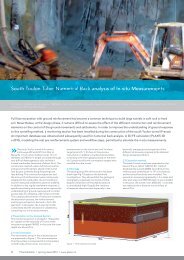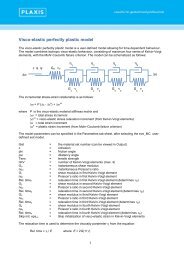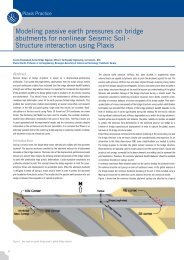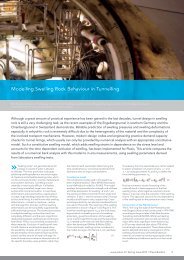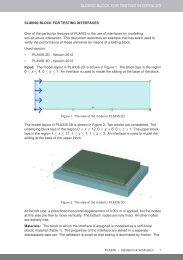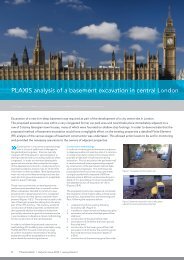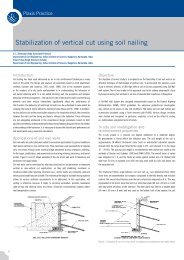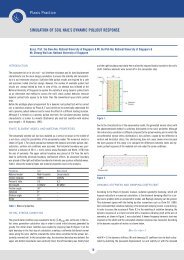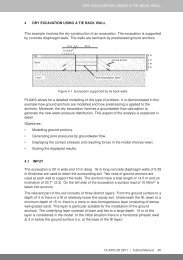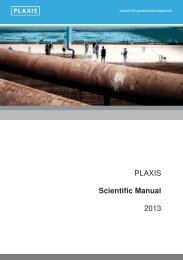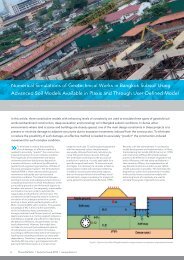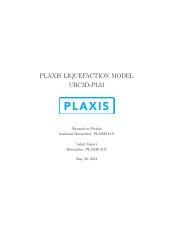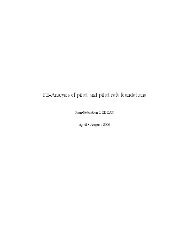Bulletin 22, Autumn 2007 - Plaxis
Bulletin 22, Autumn 2007 - Plaxis
Bulletin 22, Autumn 2007 - Plaxis
Create successful ePaper yourself
Turn your PDF publications into a flip-book with our unique Google optimized e-Paper software.
New DevelopmentsIn addition to the <strong>Plaxis</strong> 2D version, the new general <strong>Plaxis</strong> 3D model that is currentlybeing developed will have these facilities from the beginning of its existence. The internaldata structure has been designed such that properties are mainly assigned to the basicvolumes (like soil layers or excavation volumes) and are inherited by the resultingsub-volumes as soon as basic volumes are crossed with other objects. Volume propertiesare maintained when the geometry is modified. Mesh generation, generation of elementproperties from the (sub-)volumes, and initial stress generation is only considered afterdefinition of the calculation phases, just before the start of the finite element calculations.This structure guarantees the consistency of model settings and facilitates theoptimization of the model from a simplified preliminary analysis to a more detailed finalrun. More details about the new 3D model will be given in the next <strong>Plaxis</strong> bulletin.With the new <strong>Plaxis</strong> 2D update (2008) and the new 3D version (early 2009) we will fulfillstrong desires from <strong>Plaxis</strong> users, as came out of the inquiry (Figs. 1 and 2). Some ofthe new features, such as the HS small-strain stiffness model, Simulation of soil tests,and Parameter variation are already available as part of the VI<strong>Plaxis</strong> package. For moreinformation about this package see the <strong>Plaxis</strong> web site. We trust that the new releases willfurther increase the perception of user-friendliness and robustness. More importantly, itwill stimulate the improvement of accuracy of finite element simulations.Ronald Brinkgreve<strong>Plaxis</strong> bvFigure 2. Outcome of user-requiry 2005 (general remarks)Because of increasing activities, <strong>Plaxis</strong> is continuously searching for talentedprofessionals to join our Team in Delft. At the moment we have vacant positionsfor a back-office manager and for a project manager with a geo-engineering backgroundto further lead the successful <strong>Plaxis</strong> 2D development line. For details andapplications see the announcement on the <strong>Plaxis</strong> website.
<strong>Plaxis</strong> PracticeStabilization of vertical cut using soil nailingContinuationTable 2 Factors of Safety obtained using strength reduction techniqueTable 3 Horizontal displacements with excavation stages1.20 – 1.30 of recommended factor of safety for global stability, as per FHWA guidelines.Figure 3 shows the graphical representation of variation of factor of safety with the depth ofexcavation.FOSTable 2 Factors of Safety obtained using strength reduction techniqueAnother important aspect studied is the deformations in the soil nailed wall system.It could be noticed that a maximum horizontal deformation of 7.60 mm is observedfor the nailed wall, contrary to that of 27.25 mm for excavation of 6 m without nailing.This shows a significant reduction (about 70%) in the displacement of the vertical cut.Table 3 shows the comparison of extreme horizontal displacements for differentexcavation stages.Figure 3 Variation of factor of safety with the depth of excavationu x [mm]Figure 4 represent graphically the variation of extreme horizontal displacements withthe depth of excavation.In addition to the stability and deformations aspect of soil-nail wall system, variousdesign parameters with regard to development of axial forces, shear forces,moments and deformations in individual nail and facing elements were also taken intoaccount. Some of these results are as shown in Figure 5 to 8 and are summarized inTable 4. Earth pressure distribution behind the nailed wall is as shown in Figure 9. Amaximum value of 96 kN/m 2 passive earth pressure is obtained. The trend of variation offorces and moments are found to conform to theoretical expectations. It also justifies theeffectivene of numerical simulations.Figure 4 Variation of horizontal displacement of vertical cut with depth of excavationu x [mm]Figure 5 Variation of maximum horizontal displacement of nails with depth
<strong>Plaxis</strong> PracticeDesigning a bridge with <strong>Plaxis</strong> 3D tunnelP.G. van Duijnen, Movares The NetherlandsIntroductionThe High Speed Line (HSL) between Amsterdam and Brussels is not yet in operation andthere are plans to cross this railway track by local roads and motorways. Movares hascarried out a global research projects over infrastructures crossing an operational HSL.One of these research projects concerned the crossing the HSL by two large shield tunnels(15 m diameter) without generating any track deformations through tunnelling. An optionto achieve this is to construct a “support bridge” i.e. a concerte plate to avoid localsettlements of the railway track. The purpose of this support bridge is to carry the HSLtrack over the route of both shield tunnels free from eventual settlements. Figure 1 givesa 3D-view of the HSL and crossing tunnels. The global dimensions of the support bridgewere calculated with the <strong>Plaxis</strong> 3D tunnel program in an early stage of design.The Support BridgeFigure 1 gives a 3D artist impression of the support bridge, shield tunnels and the HSL.Figure 2 presents the <strong>Plaxis</strong> 3D model with the main components of the bridge.<strong>Plaxis</strong> 3D ModelSolid elements are used for primary, secondary beams and concrete plate. All abutmentssupport the main beams in a vertical and rotational direction. Because of rotation support,every abutment has two fixed-end anchors. The abutment in the middle sectionsupports the main beam also in a horizontal direction; horizontal fixed-end anchors areadded in longitudinal direction (acceleration and break forces). One fixed-end anchor isadded in transverse direction for numerical integrity.This article gives a short description of the 3D <strong>Plaxis</strong> model, the model difficulties andcalculation results.Figure 2: <strong>Plaxis</strong> 3D model with main parts.Figure 1: 3D picture of the HSL track, new support bridge and shield tunnels.Background information HSLIn the Netherlands, the HSL is mainly built on a concrete plate on pile foundation. Thebearing piles are driven to a depth of 15 to 20 m below the surface. The bottom of theshield tunnel is situated just under the toe of the piles. The tunnelling process will reducethe bearing capacity of the pile foundation and settlement of railway track is expected.It’s assumed that such a support bridge should prevent (differential)settlement of the railway track.Why <strong>Plaxis</strong> 3D Tunnel?The support bridge is a complex asymmetrical construction. The question asked is: is thebridge capable of meeting the HSL deformation requirements and can this be modelledwith <strong>Plaxis</strong> 3D? Rough calculations by hand do not provide these answers. <strong>Plaxis</strong> 2D hasbeen used for predictions of settlement caused by the tunnelling process.Some special modelling features need to be taken into account, which are indicated intable 1Do’s- Add fictitious inactive slices on both ends of the model. Fictitious inactive slicesovercome problems with the standard boundary conditions at both ends of themodel.- Define separate material data set for each abutment. Separate material sets make iteasier to change the vertical stiffness of the abutment during calculation.- Two fixed-end anchors models each abutment, to provide rotation stiffness forthe main beams.Remarks- It was considered including plate elements in the primary and secondary beams.Plate elements with a fictitious, low bending stiffness, simplifies presentation ofbending moments, normal forces etcetera. The use of plate elements was rejectedbecause bending moments occur in diverse directions.Table 1 special modelling features10
<strong>Plaxis</strong> PracticePost processing, deformations andreaction forcesDuring normal train operations, the key element to consider is global deformationsand differential deformations. Settlements of track are obtained in <strong>Plaxis</strong> 3D throughgenerating a cross section at track level. Numerical deformations are thereafter copiedinto an Excel sheet for further processing. Figure 3 shows the deformed support bridge.Figure 4 shows the settlements of the main beams, the railway tracks and the reactionforces of abutments for load case B (load case B being the situation where one train ison the bridge). Figure 5 shows the bending moments in the main beam for the differentload cases.Tunnelling ProcessSettlements of the abutments as a result of the tunnelling process were expected forthe abutments situated close to the tunnels. Settlements of the abutments caused bythe tunnelling process are modelled by reducing the vertical stiffness of the support.The amount of reduction applied is an iterative process. The calculated settlement ofthe abutment had to comply with the predicted settlement induced by the tunnellingprocess.Post processing, bending momentThe plate elements were not included in the model. Bending moments are obtained byintegrating the stresses over the height of the main beam.Calculation of the bending momentsFor the cross sections A-A, B-B and C-CM AA(z) = ∑σ zz;i(z)⋅A i⋅y iBending moment in Main Beam:M(z) = 1/3⋅(M AA(z) + M BB(z) + M CC(z))Figure 3: deformed support bridgeM(z)M AA, M BB, M CCA iAσ zz(y,z)y DZBending moment around X-X.Bending moment cross section A-Arespectively B-B and C-C.area for σzz(y,z)stress in longitudinal direction incross section A-A, B-B and C-C.distance to X-XZ-coordinateBending moment [kN m/m]reactionforce [MN]Settlement [mm]Bending moment [kNm]Figure 4: settlements of the main beamsFigure 5: bending moments in the main beamConclusions- The definition of the boundary conditions gave a few difficulties;- Modelling the support bridge with <strong>Plaxis</strong> 3D posed no difficulties;- The post processing of the numerical results is a time consuming process;- The copy option of slides and planes in the calculation model proved to be a usefultimesaver;- Herewith the structure complies with the deformation requirements;- There is a good concordance between the results of the <strong>Plaxis</strong> 3D calculation with otherFEM programs such as Ansys (not presented here).11
<strong>Plaxis</strong> PracticeTangiers - Mediterranean harborSylvie Bretelle, Bruno Demay, Agathe Touati, SAIPEM-SA1. IntroductionOn the south bank of the Gibraltar’s Strait 40 km east of Tangiers city, the Moroccoauthorities have launched the construction of a new harbor, to favor the economicaldevelopment of the North region and to improve the relationship between Morocco andthe Euro-Mediterranean area. The main functions of the harbor are:- Getting a part of the traffic of the containers transshipment- Developing the traffic of trucks- Rationalizing the affectation of the cereals traffic- Serving the Tangiers hinterland with refined oil products- Clearing the city of Tangiers, in order to turn its activity more to the tourism and makeit as a pole of a cultural center.The works are performed by a joint venture company (SRPTM) constituted by:- BOUYGUES-TP- SAIPEM-SA- BYMARO (Morocco subsidiary company of Bouygues-BI)2. Project description2.1 GeneralThis project, named “Tangiers - Mediterranean harbor “, was initiated to create a harborin deep water, free zones of logistic, industrial, commercial and tourist facilities andinfrastructures of motorways and railways connections.Figure 2: Aerial view of the harbor- A <strong>22</strong>5 m length utility quay, with a draught of 6 m.2.2 Description of rubble moundThe rubble mound is realized with materials from quarry, placed by maritime or terrestrialway (Dumping from ship when water depth exceeds 10m, dumping from truck and pushedfrom land at shallow water depth). It is located in depths not exceeding 20 m. Its totallength is around 1,000 m.Figure 3: Detailed vew of breakwaterFigure 1: Tangiers-Mediterranen harbor projectThe harbor of Tangiers-Mediterranean is protected by a main breakwater of 2,050 mlength and a secondary breakwater of 570 m length. Both breakwaters are composed ofone part of rubble mound and the other part of caissons depending upon the sea bed level.This breakwater will protect terminals to be erected later:- A container terminal of 1,612 m length, offering a draught of 12 to 18 m anda reclamation area of 90 hectares.- A 201 m length of quay, for feeders with a draught of 12 m.- A cereal terminal with a 366 m length of quay, with a draught of 15 m.2.3 Description of breakwaterThe Breakwater is constituted of 40 caissons based at level -20 m and placed one closeto the other, along a total length of around 1,100 m. The horizontal dimensions of onecaisson are 28x28 m and the height is 32 to 35 m. The caissons are longitudinallyconnected by means of concrete keys. The total concrete volume is 3,000 m3 per caisson.Caissons are filled with ballast in order to ensure installation and service stability.The weight of each unit is 7900 T.12
<strong>Plaxis</strong> Practice2.4 Description of the caissonsThe caissons are made of precast reinforced concrete and have 4 cells shape (sharmrockshape) filled with sand on a height of 23 m. Above this the superstructures are constructedconstituted by three walls.- A partially opened front wall (in order to reduce the swell energy),- a rear wall as a screen to the swell- a transverse wall to link the two previous walls.3. Geological contextAccording to detailed site investigation (CPT, boreholes, SPT, laboratory testing), severalbasement soils were identified. The geotechnical context is as follow:Rubble mound breakwater:Based on a bedrock composed of slightly to highly weathered siltstone/sandstone flysch (flyschis a thick deposit of distinctively interbedded sandstones and shales laid down by turbiditycurrents in a deep water marine environment during the early phases of orogenesis).Caissons breakwater:Based on soils (silts, sands and gravels), with foreseen settlements:- FORMATION I: is mainly composed of sand,- FORMATION II: Interbedded gravelly sand, clays and sandy gravel or clayey gravel.- FORMATION III: Sandstone/siltstone substratum.4. Simulation with <strong>Plaxis</strong> 2D4.1 Soil Model<strong>Plaxis</strong> was used to estimate the settlements (both global and differential) of the caissons.For this purpose, the different soil layers were considered with the following soil model:Figure 4: Detail of caissonGeneral layout of the harbor is shown in the next picture, with caissons dike in the upperpart of the drawing, and turning basin in the middle.Formation I: Hardening Soil Model, HSM in drained conditions (parameters defined fromcalibration on triaxial tests results). (soils 1-2-3 in table below)Formation II: Soft Soil Model, SSM for clayey layers with available oedometer tests resultsto define C c, C se0. Mohr Coulomb elasto-plastic model, EPMC for other gravely layers.(soils 4-5 in table below)Formation III: Mohr Coulomb elasto-plastic model, EPMC with non porous conditions.Parameters are defined from in-situ tests and correlations.One of the calculated cross section is shown here after, with a detailed table of theparameters used for the calculation.Figure 5: Harbor planTable 1: Soil dataFigure 6: Cross section of caisson13
<strong>Plaxis</strong> PracticeTangiers - Mediterranean harborContinuation4.2 Construction stages and estimated settlementsConstruction stages are described here after for two sections part of the study.Cereal quay area (PM 1000 et PM1<strong>22</strong>5)- Preparation of platform for caisson (between sea bed at -25m and caisson bottomat -20 m)- Caisson installation and ballast- Superstructure cast in place- 2 month consolidation before backfilling behind the caissons- Backfilling behind the caissons by 5 m height layers (in the model, to obtain arepresentative stress distribution), no consolidation allowed between backfillingstages- Long term consolidation (up to full dissipation of excess pore pressure).Outside cereal quay area (PM 1475)- Preparation of platform for caisson (between sea bed and caisson bottom at -20 m)- Caisson installation and ballast- Superstructure cast in place- Long term consolidation (up to full dissipation of excess pore pressure).The <strong>Plaxis</strong> mesh is as follows:PortsideSeasideThe <strong>Plaxis</strong> mesh is as follows:SeasideFigure 8: <strong>Plaxis</strong> model of caissonThe table summarizes the main results from the calculation of caisson settlement(seaside, port side and on caisson axis).Figure 7: <strong>Plaxis</strong> model of cereal quay areaThe table summarizes the main results from the calculation of caisson settlement(seaside, port side and on caisson axis).PM 1<strong>22</strong>5Port(cm) Axis(cm) Sea(cm)Preparation of platform for caisson+ 5 months consolidation 7.2 7.8 8.0Caisson installation and ballast+ 5 months consolidation 39.6 37.1 34.5Superstructure cast in place+ 2 months consolidation .1 2.4 2.8Backfilling behind the caisson 7.6 5.9 4.2Long term consolidation 11.1 10.0 8.9Total caisson settlement 60.5 55.4 50.3Table 2: Calculated displacements (quay)PM 1475Port(cm) Axis(cm) Sea(cm)Preparation of platform for caisson+ 5 months consolidation 7.2 7.8 8.0Caisson installation and ballast+ 5 months consolidation 39.6 37.1 34.5Superstructure cast in placeTotal caisson settlement 60.5 55.4 50.3Table 3: Calculated displacements (caisson)14
<strong>Plaxis</strong> Practice5. Observed behavior during construction –comparison with <strong>Plaxis</strong> calculationThe compared observed behavior and calculated behavior are shown in this page,resulting in a good agreement. The first part of the curve correspond to the concretecaisson installation, and the observed step correspond to the ballast installed inthe caisson.installed in the caisson.Main data considered for dynamic simulation are:- Soil conditions / substratum position as shown in next picture- Dynamic modulus (6 times static modulus) as laboratory tests shows a ratio between5 and 8installed in the caisson.CAISSON N°11 - PM 1<strong>22</strong>9Tassements Settlement (cm)CAISSON N°11 - PM 1<strong>22</strong>917/06 24/06 01/07 08/07 15/07 <strong>22</strong>/07 29/07 05/08 12/08 19/08 26/08 02/09 09/09 16/09 23/09 30/09 07/10 14/10 21/10 28/10 04/11 11/11 18/11Tassements0.0Settlement (cm)Date-0.117/06 24/06 01/07 08/07 15/07 <strong>22</strong>/07 29/07 05/08 12/08 19/08 26/08 02/09 09/09 16/09 23/09 30/09 07/10 14/10 21/10 28/10 04/11 11/11 18/11-0.2 0.0-0.3 -0.1 DateTassem ent Tassem [m ] ent [m ]-0.4-0.2 -0.5 -0.3 -0.6 Calculated value-0.4 -0.7 -0.5 -0.8 -0.6 Calculated value -0.9 -0.7 -1.0 -0.8 P1P2P3BALLASTAGE EN SABLE DALLE SUPERIEURE-0.9relevé relevé relevé-1.0Figure 9: Observed vs calculated settlementsP1relevéP2relevéP3BALLASTAGE EN SABLErelevéCAISSON N°20 - PM 1481TassementsSettlement (cm)DALLE SUPERIEURECAISSON N°20 - PM 148106/08 13/08 20/08 27/08 03/09 10/09 17/09 24/09 01/10 08/10 15/10 <strong>22</strong>/10 29/10 05/11 12/11 19/11Tassements0.0Settlement (cm)-0.106/08 13/08 20/08 27/08 03/09 10/09 17/09 24/09 01/10 08/10 15/10 <strong>22</strong>/10 29/10 05/11 12/11 19/11-0.20.0DateDateFigure 11: <strong>Plaxis</strong> modelSeismic signal: defined from existing seismic data to represent as much as possiblethe frequency content of most probable seism.- Kocaeli (distant) Mw 8.5 a max0.093g- Umbria (close) Mw 4.7 a max0.24g- Signal imposed at rock substratum level.- Dilatancy sensitivity analysisTassem ent [m Tassem ] ent [m ]-0.3-0.1-0.4-0.2-0.5-0.3-0.6-0.4-0.7-0.5-0.8-0.6 Calculated valueCalculated value-0.9-0.7-1.0-0.8 -0.9P1relevéP2relevéP3relevé-1.0P1 P2relevé relevéFigure 10: Observed vs calculated settlementsP3relevéFigure 12: Typical short duration seismic event6. Dynamic simulationA dynamic soil structure interaction was performed in order to confirm the validity ofpseudo static calculation and to quantify settlements and rotations of caissons duringseismic event. In addition, the pore pressure increase will be considered with regard tothe liquefaction phenomena.Figure 13: Typical long duration seismic event15
<strong>Plaxis</strong> PracticeTangiers - Mediterranean harborThe dilatancy angle has an influence on the volume change of soil due to shear.For static analysis, the retained dilatancy angle value was 0° < ψ < 0.5° allowing porepressure generation during construction loading. This choice gives a proper correlation ofobserved and calculated settlement.α R= β R= 0.01 (default values) and α R= β R= 0.03 are considered for sensitivity analysis(proposed value in different reference sources).For sensitivity purpose, values of 5° < ψ < 10° (ψ = j - 30°, correspond to the usualvalue) were compared to the case with ψ = 1° (correspond to the value retained for staticcalculation).The results show similar displacements.Ψ = ϕ - 30° ↑Ψ = 1°↓The results show similar excess pore pressure.α and β = 0.01 ↑ Dmax = 88 mm,α and β = 0.03 ↓ Dmax = 83 mm,- Rayleigh Parameters and sensitivity analysisΨ = ϕ - 30° ↑Ψ = 1°↓α and β = 0.01 ↑ extreme pore pressure 130 kPaα and β = 0.03 ↓ extreme pore pressure 316 kPa16
<strong>Plaxis</strong> Practice- Number of step sensitivity analysisFor the short duration seismic event, the application time was set to 10s and the time stepto 0.2s (or 500 steps) or 0.01s (or 1000 steps for sensitivity analysis).The used time step shall be lower than critical time step. The critical time step isa function of element size, shear moduli, and volumic weight of soils.The calculation was performed with 500, 700 and 1000 steps in order to controlthe critical step number. Results shown are displacements.The results are very similar for 700 to 1000 steps, whereas the results changedramatically for 500 steps. For 500 steps, the time step is probably lower than criticaltime step.7. Results of the <strong>Plaxis</strong> dynamic analysisThe main results of this <strong>Plaxis</strong> dynamic analysis are:- An accurate choice of the parameters is required (seismic signal, soil models andparameters) with dedicated soil investigation (both in situ and in laboratory), andseismic study,- Precise answers are found related to amplification or attenuation of the seismic signalbetween substratum and structure,- Localization of the higher pore pressure increase (zone of possible liquefaction),- Quantification of the residual displacements after seism.Some sensitivity analysis on different parameters help to define specific parameters forthe dynamic model such as time steps, Rayleigh parameters and dilatancy.Nb step = 1000↑ dmax =88 mmNb step = 700↑ dmax =82 mmNb step = 500↑ dmax =147 mm17
Recent ActivitiesRecent activitiesProduct Information3DFoundation is designed for the analysis of raft, pile-raft and offshore foundations.Large arbitrary 3D soil geometries and meshes can easily be generated by the definitionof one or more boreholes. Structures or structural parts and piles can be definedindependent of non-horizontal soil stratigraphy by well defined dedicated wizards.Version 2 of the PLAXIS 3DFOUNDATION program offers additional functionality comparedto previous releases. New features include embedded piles, ground anchors, user definedsoil models, vertical mesh refinement, Phi/c reduction user defined boundary conditionsfor consolidation. Further features include multiselect and grouping, the hardwareaccelerated display of graphical output data and the possibility to create animationsof the results. Via the V.I.<strong>Plaxis</strong> Service Program of 3DFoundation users can also haveaccess to the new Small Strain Stiffness model (HSsmall) and the Soil Test facility. Seealso our movies at www.plaxis.nlIn the process of adapting our products and services to a particular language, culture,and desired local features we started a few years ago to unicodify our products.In 2006 we released the Japanese and Chinese <strong>Plaxis</strong> V8 and in the framework ofthese localization we recently announced a Russian language website www.plaxis.ruand the Indonesian <strong>Plaxis</strong> V8. From the Japanese and Chinese V8 we also releasedan introductory version. These are part of a completely refreshed <strong>Plaxis</strong> Introductory. ThisIntroductory Version is intended to show (new) users most of the available options of the<strong>Plaxis</strong> programs and includes:- <strong>Plaxis</strong> At Work movies- <strong>Plaxis</strong> V8 Introductory- Chinese <strong>Plaxis</strong> V8 Introductory- Japanese <strong>Plaxis</strong> V8 Introductory- 3DTunnel Introductory- 3DFoundation IntroductoryThe introductory version is workable like the full versions but limited in some ways.18
Recent ActivitiesUsers ServicesSo far <strong>2007</strong> is a successful year with respect to courses as most courses have reachedthe maximum amount of participants. Next to the yearly courses in Holland, Belgium,Germany and the UK a new course has been held in India. This course inChennai was conducted in cooperation with the Indian Institute of Technology – Madras.The course was very well attended with over 50 participants. In South-East Asia therehave been workshops and seminars in Vietnam, Thailand and Malaysia. Furthermorethe IEM organized a course in Malaysia with almost 100 participants. The annual coursesin the USA were this year in Berkeley (January) and Chicago (July) with especially the latterone well visited. Australia saw in <strong>2007</strong> its first Advanced course. This 3 days coursein Sydney had 25 enthusiastic participants.For the remaining part of the year the first Advanced course in Turkey was planned andto our surprise and delight this course was already full more than 2 months before thecourse was actually held. At about the time of the release of this <strong>Plaxis</strong> bulletin after a 5years period since the first course in Brazil (2002, Sao Carlos) another course in Brazil willtake place. This time it will be more an intermediate level course of 4 days. Other coursesthis year are planned in Indonesia and Colombia.As extension of the Advanced course in Sydney, on the evening of Thursday 26 Junethe first Australian-New Zealand Users meeting was held. Though the group of attendantswas not very large there where some interesting presentations and discussions.A dam design was discussed, focusing on the use of different advanced soil modelsfor this particular case. The evening was closed with a presentation on future <strong>Plaxis</strong>developments with respect to 3D. Considering the positive reactions of the attendantsmore user meetings are planned as part of future courses in Australia or New Zealand.A 2-day Russian Users Conference with about 85 participants was organized as asuccessor of last year User Day in St. Petersburg.We look forward to meet you in our upcoming events.For the 14th European <strong>Plaxis</strong> Users Meeting you can register online via our Agenda onwww.plaxis.comRussia (top)Malaysia (middle)India (bottom)19



